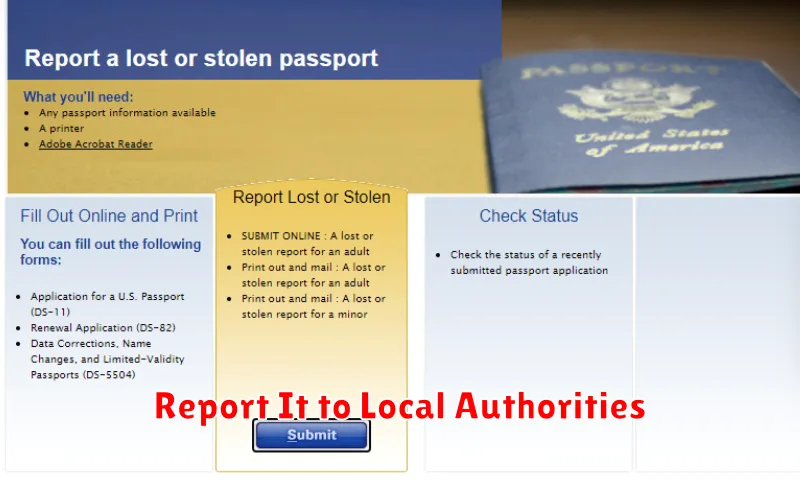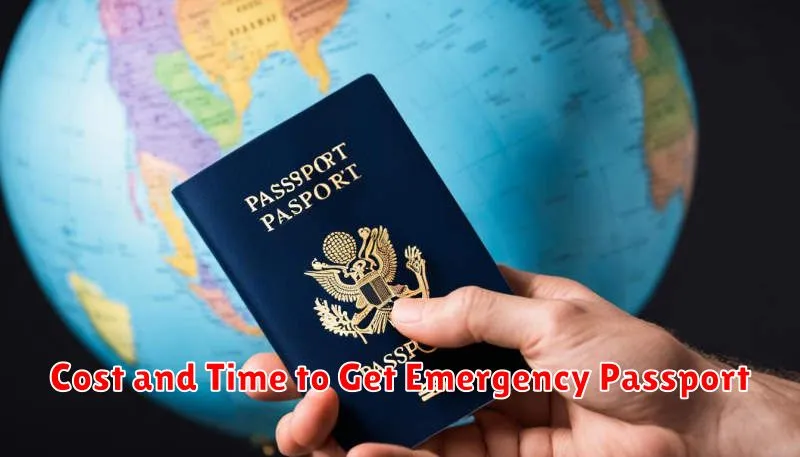Losing your passport overseas can be a stressful and disorienting experience. It is a crucial travel document that proves your identity and citizenship, and its absence can significantly disrupt your travel plans. Knowing what steps to take if you find yourself in this unfortunate situation can mitigate the inconvenience and help you get back on track. This article will guide you through the necessary procedures to follow if you lose your passport abroad, covering everything from initial reporting to obtaining an emergency travel document. We will address crucial aspects, including contacting the appropriate embassy or consulate, understanding required documentation, and navigating the process of acquiring a replacement passport. Whether you are a seasoned traveler or embarking on your first international trip, understanding these steps is essential for a safe and worry-free journey.
Losing your passport overseas can transform a dream vacation into a logistical nightmare. From cancelled flights and accommodation issues to potential legal complications, the repercussions can be significant. This guide provides practical advice and a step-by-step approach to help you manage this challenging situation effectively. We will equip you with the information you need to replace your lost passport as quickly and efficiently as possible, minimizing disruption to your travels. We will also discuss preventative measures you can take before traveling abroad to mitigate the risk of passport loss and prepare for such contingencies. With our comprehensive guide, you will be prepared to navigate the process of passport replacement overseas with confidence and ease. Learn what to do if you lose your passport while traveling abroad and empower yourself with the knowledge to overcome this travel obstacle.
Stay Calm and Act Quickly
Discovering a missing passport while abroad can be incredibly stressful, but it’s crucial to remain calm and act swiftly. Panic will only hinder your ability to take the necessary steps toward resolution.
First, secure your belongings and retrace your steps. Think back to the places you’ve visited since you last saw your passport. Thoroughly check your bags, hotel room, and any transportation you’ve used. If your passport is truly lost or stolen, the next step is to report it.
Contact the nearest embassy or consulate of your home country as soon as possible. They will guide you through the process of obtaining an emergency travel document, which will allow you to return home. Be prepared to provide them with identifying information, such as your full name, date of birth, and place of birth, as well as details about your lost passport (e.g., passport number, date of issue). You may also need to provide a police report if your passport was stolen.
Report It to Local Authorities

After you have contacted your embassy or consulate, the next crucial step is to report the loss or theft of your passport to the local police or other relevant authorities. This is essential for several reasons. First, it creates an official record of the incident, which can be helpful for insurance claims and other official processes. Second, a police report may be required by your embassy or consulate to issue an emergency passport.
When reporting the incident, provide as much detail as possible, including the date, time, and location of the loss or theft. If your passport was stolen, describe any suspicious individuals or circumstances. Retain a copy of the police report for your records. It is also important to obtain a case or reference number for future inquiries.
Visit the Nearest Embassy or Consulate
Losing your passport overseas can be a stressful experience, but taking swift action is crucial. Your first step should be to contact the nearest embassy or consulate of your home country.
Embassy and consulate staff are trained to assist citizens in such situations. They can provide essential services, including helping you file a police report (if necessary) and issuing an emergency passport. This temporary passport will allow you to travel back to your home country or to your next destination, depending on your circumstances.
Be prepared to provide as much information as possible. This includes your name, date of birth, place of birth, passport number (if you remember it), and details surrounding the loss or theft of your passport. Having a photocopy of your passport, or a digital copy stored on your phone, can also be incredibly helpful.
Locating your nearest embassy or consulate can usually be done through a quick online search or by contacting your country’s foreign affairs department. Be aware that embassies and consulates often operate during specific hours, so check their website or contact them beforehand to confirm their availability.
Provide ID and Supporting Documents
After contacting the nearest embassy or consulate, you will need to provide identification and supporting documentation to help them verify your identity and citizenship. This is crucial for issuing a replacement passport.
Acceptable forms of ID might include a driver’s license, birth certificate, or a photocopy of your lost passport. If you don’t have these documents with you, the embassy or consulate staff can advise you on alternative options. They may be able to use other government-issued identification or contact people back home who can provide necessary documents.
You will also need to provide supporting documentation for your passport application. This typically includes a completed passport application form, recent photographs, and proof of your travel plans (such as your airline ticket). Embassy or consulate staff will guide you through this process and inform you of any specific requirements.
The more documentation you can provide, the easier and quicker the replacement process will be. Keep in mind that having some form of identification, even a photocopy, will significantly expedite the process.
Cost and Time to Get Emergency Passport

Replacing a lost or stolen passport overseas involves fees and processing time. The cost of an emergency passport varies depending on your citizenship and the issuing country. U.S. citizens, for example, can expect to pay a similar fee as a regular passport book, currently around $165. Other countries may have different fee structures.
Obtaining an emergency passport generally takes less time than a full passport renewal, but it’s not instantaneous. Processing times can vary greatly depending on the workload of the embassy or consulate and the specific circumstances. While some locations might issue an emergency passport within 24 hours, others could take several days or even a week. It’s crucial to contact the nearest embassy or consulate as soon as possible to understand the expected timeframe in your specific situation.
Be prepared for potential additional expenses beyond the passport fee itself. These might include travel costs to and from the embassy or consulate, expedited shipping fees if necessary, and any local accommodation expenses incurred during the waiting period.
Notify Your Travel Insurance Provider
Contacting your travel insurance provider is a crucial step after losing your passport. Many policies offer coverage for passport replacement fees, emergency travel documents, and even accommodation expenses incurred due to delays. Thoroughly review your policy to understand the specific coverage and procedures you need to follow.
Be prepared to provide your policy number, details about the loss of your passport (when and where it occurred), and any police reports filed. Your provider may have specific requirements for documentation or procedures, so it’s vital to contact them as soon as possible. Prompt notification can expedite the reimbursement process and ensure you receive the appropriate assistance.
Keep records of all communication with your insurance provider, including names of representatives, dates, and times of calls or emails. This documentation can be invaluable if any disputes about your claim arise later.
Prevent It from Happening Again
Losing your passport once is a stressful enough experience. Taking preventative measures can significantly reduce the risk of it happening again. One of the most effective strategies is to make copies of your passport. Create both physical photocopies and digital scans, storing them separately from your original document.
Consider leaving a physical copy with a trusted friend or family member back home, while saving digital scans to a secure cloud storage service. This ensures you have access to essential information, even if your physical copies are lost or stolen alongside your passport.
While traveling, carry your passport in a secure and discreet travel pouch or money belt worn under your clothing. Avoid leaving it in easily accessible bags or pockets. When staying in hotels, utilize the in-room safe for storing valuables, including your passport, whenever possible.
Be mindful of your surroundings, especially in crowded areas known for pickpocketing. Staying vigilant can help prevent theft and ensure your passport remains safe.

